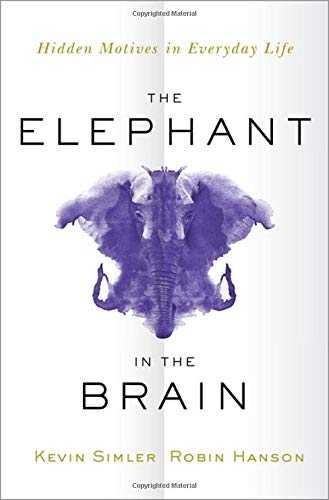Your one stop book summary, audiobook and book review spot for:
The Elephant in the Brain Summary
About The Elephant in the Brain Book
Human beings are primates, and primates are political animals. Our brains, therefore, are designed not just to hunt and gather, but also to help us get ahead socially, often via deception and self-deception. But while we may be self-interested schemers, we benefit by pretending otherwise. The less we know about our own ugly motives, the better - and thus we don't like to talk or even think about the extent of our selfishness. This is "the elephant in the brain." Such an introspective taboo makes it hard for us to think clearly about our nature and the explanations for our behavior. The aim of this book, then, is to confront our hidden motives directly - to track down the darker, unexamined corners of our psyches and blast them with floodlights. Then, once everything is clearly visible, we can work to better understand ourselves: Why do we laugh? Why are artists sexy? Why do we brag about travel? Why do we prefer to speak rather than listen?
Our unconscious motives drive more than just our private behavior; they also infect our venerated social institutions such as Art, School, Charity, Medicine, Politics, and Religion. In fact, these institutions are in many ways designed to accommodate our hidden motives, to serve covert agendas alongside their "official" ones. The existence of big hidden motives can upend the usual political debates, leading one to question the legitimacy of these social institutions, and of standard policies designed to favor or discourage them. You won't see yourself - or the world - the same after confronting the elephant in the brain.
See More
4.9/5 (5992 reviews)
Audio and text
Download free PDF
A phenomenal book on understanding your own "hidden motivations in everyday life" and why we do what we do. Widely applicable to all parts of life, and the kind of explanations you can't stop thinking about after reading.
Elephant In The Room vs Elephant In The Brain
- EIR- An important issue that people are reluctant to acknowledge or address.
- EIB- An important but unacknowledged feature of how our minds work; an introspective taboo.*
We, human beings, are a species that’s capable of acting on hidden motives. Our brains are built to act in our own self-interest while at the same time trying hard not to appear selfish in front of other people. Self-deception is therefore strategic, a ploy our brains use to look good while behaving badly.
395
Animal Behavior
- Primate grooming is about politics
- By grooming each other they help forge alliances that help them in other situations
- This explains why grooming time across species is correlated with the size of the social group, but not the amount of fur
- Larger groups have, on average, greater political complexity, making alliances more important but also harder to maintain.
333
Competition
- Our ancestors got smart primarily to compete against each other in a variety of social and political scenarios.
- Social challenges, such as competition for mates, jockeying for social status, coalition politics (alliances, betrayals, etc.), intra-group violence, cheating, and deception, pit humans against other humans and are therefore competitive and potentially destructive.
330
"The Elephant in the Brain" provides valuable insights into human behavior, shedding light on the often-hidden forces that drive our decisions and interactions. It encourages readers to look beneath the surface and question their own motivations and the motives of others in various aspects of life.
Top 10 key insights we can gain from "The Elephant in the Brain."
"The Elephant in the Brain: Hidden Motives in Everyday Life" is a thought-provoking book by Kevin Simler and Robin Hanson that explores the hidden motives and unconscious behaviors that drive human decision-making and social interactions:
- Hidden Motives
- Self-Deception
- Social Status
- Altruism and Charity
- Hypocrisy
- Self-Interest in Relationships
- Education
- Healthcare
- Art and Entertainment
- Religion
175
1. **Hidden Motives**:
Much of human behavior is driven by hidden motives, and we often deceive ourselves about our true reasons for doing things.
"We frequently fool ourselves, taking our own explanations seriously and at face value when, in fact, they are just stories, rationalizations for our actions."
173
2. **Self-Deception**:
Humans are experts at self-deception, constructing plausible explanations for their actions that mask their true, often self-interested, motives.
"Our minds consist of a multitude of subagents, each with its own agenda and motives, which can often conflict with one another."
168
Self-deception
A ploy our brains use to look good while behaving badly.
2
Supercharge your mind with one idea per day
Enter your email and spend 1 minute every day to learn something new.
I agree to receive email updates
